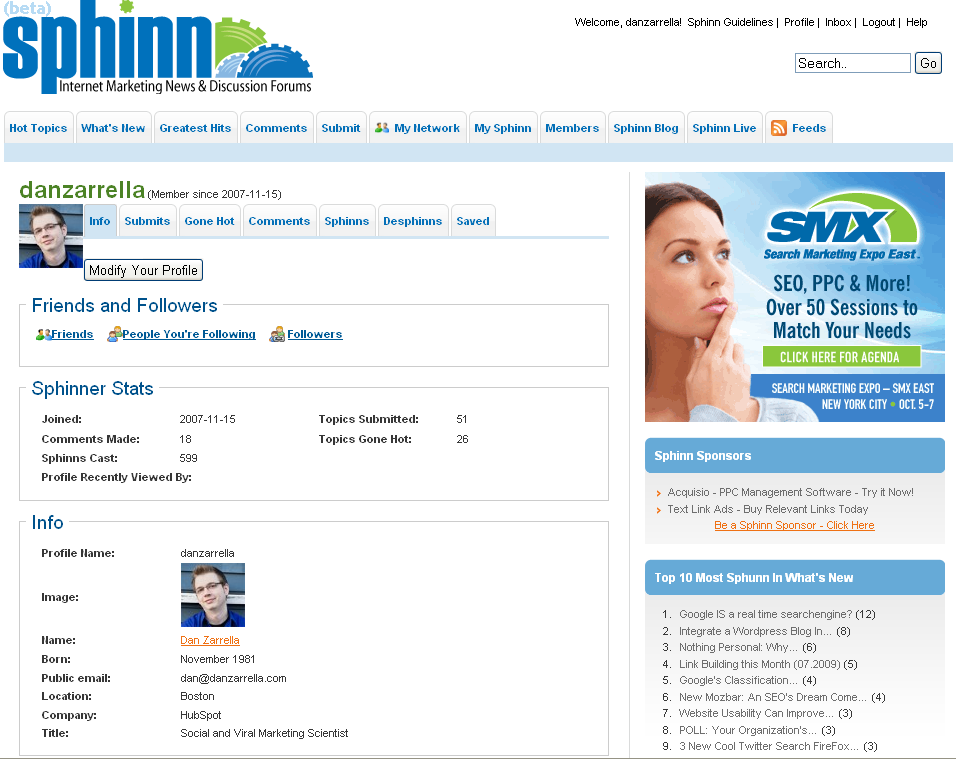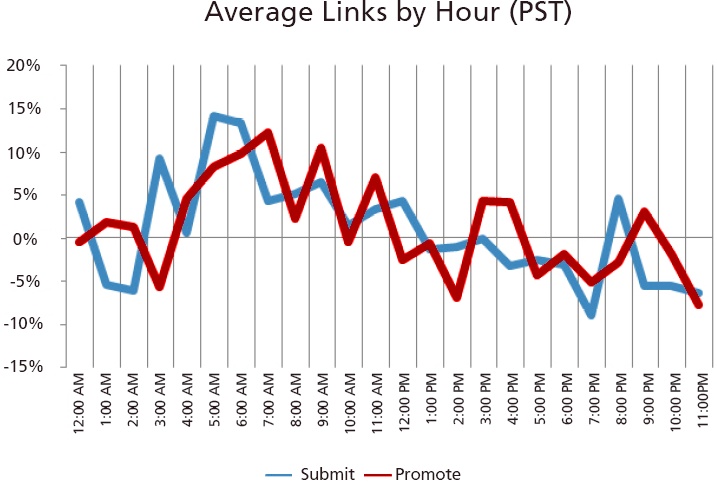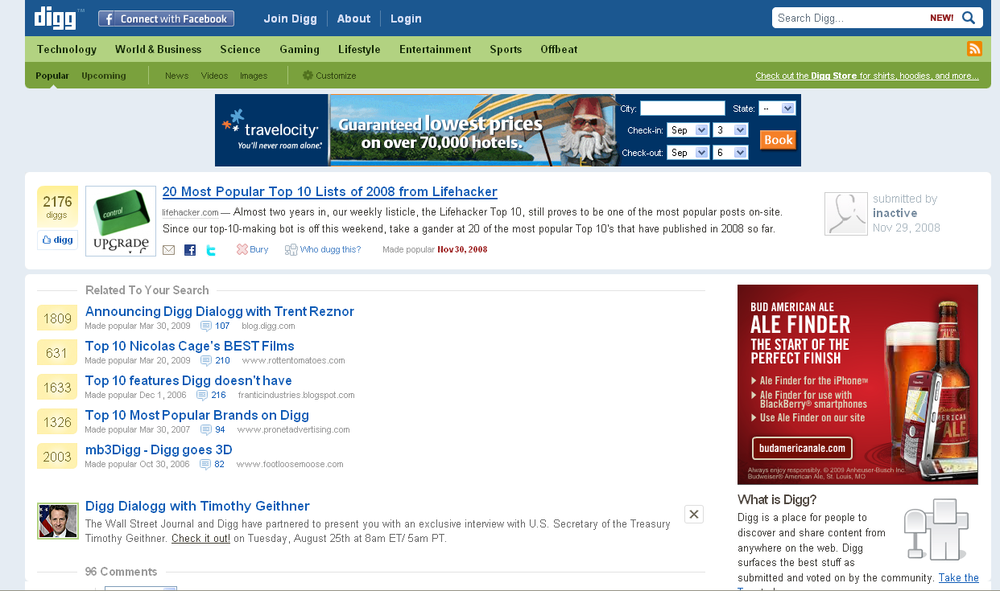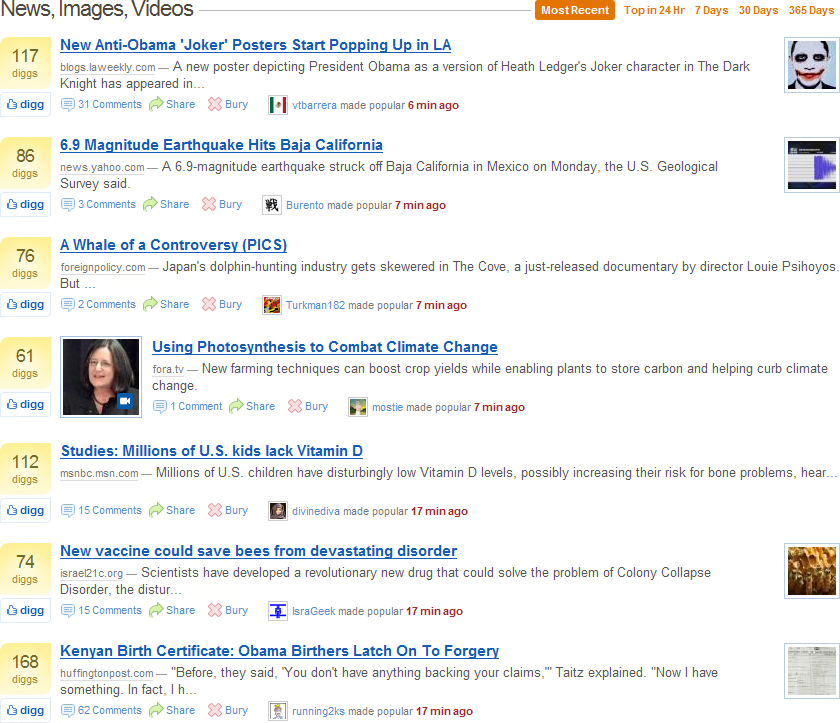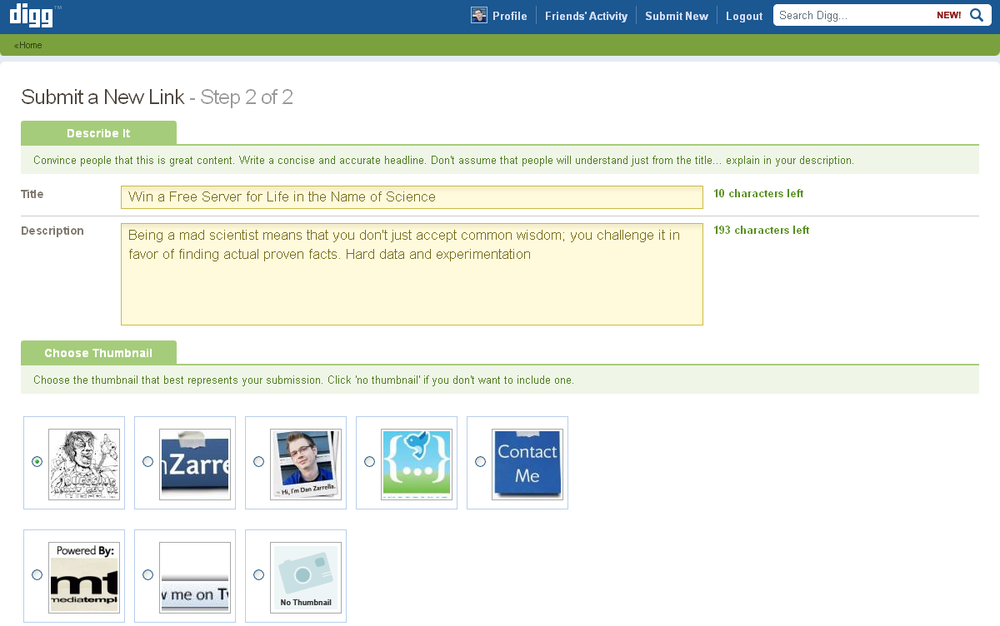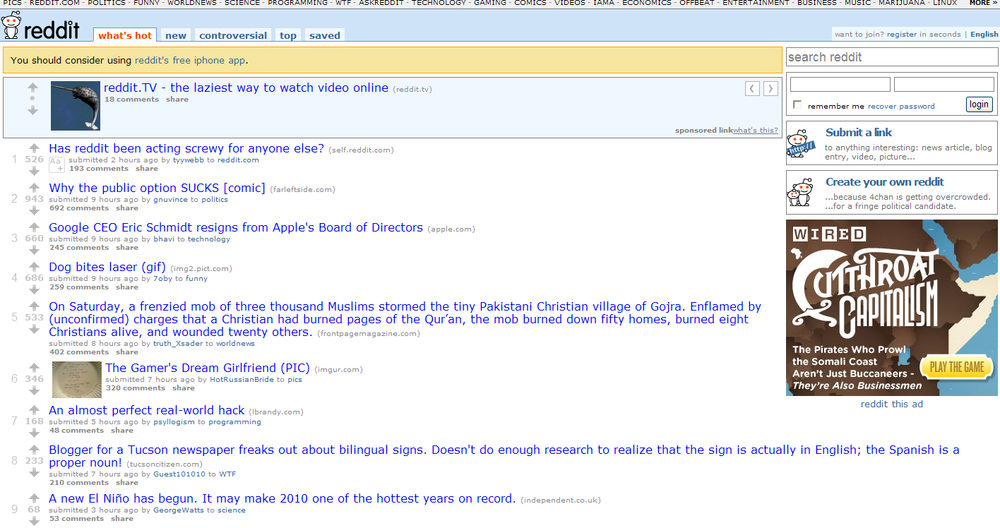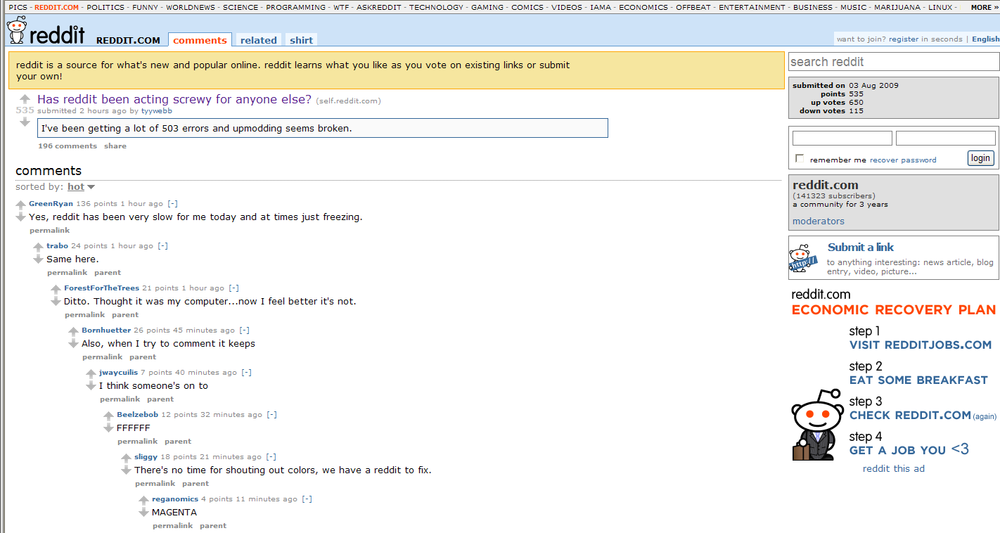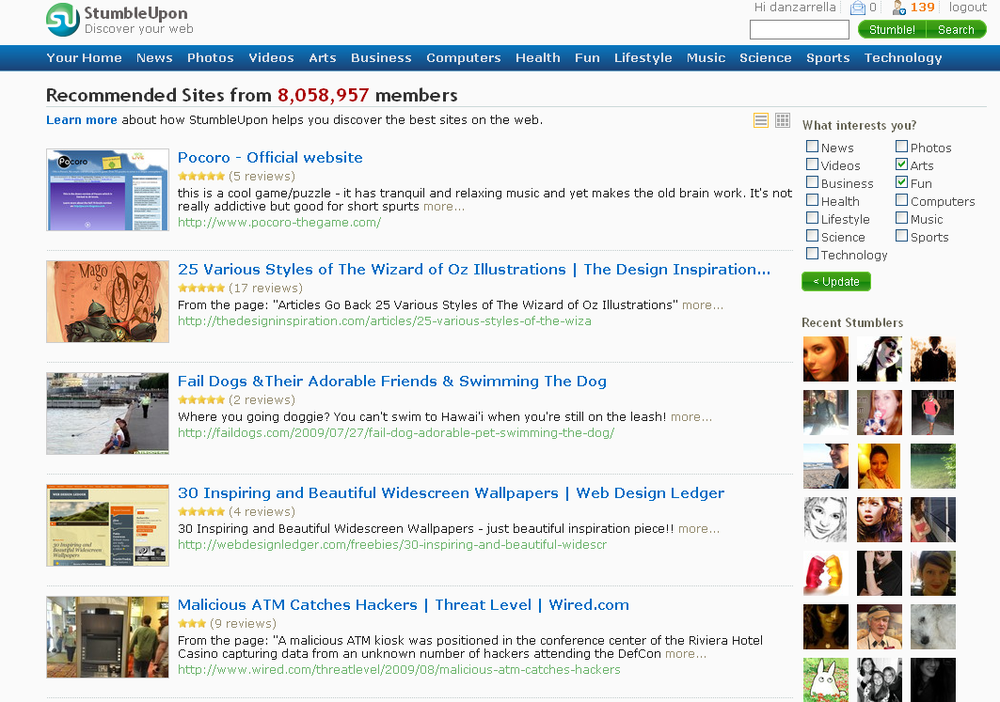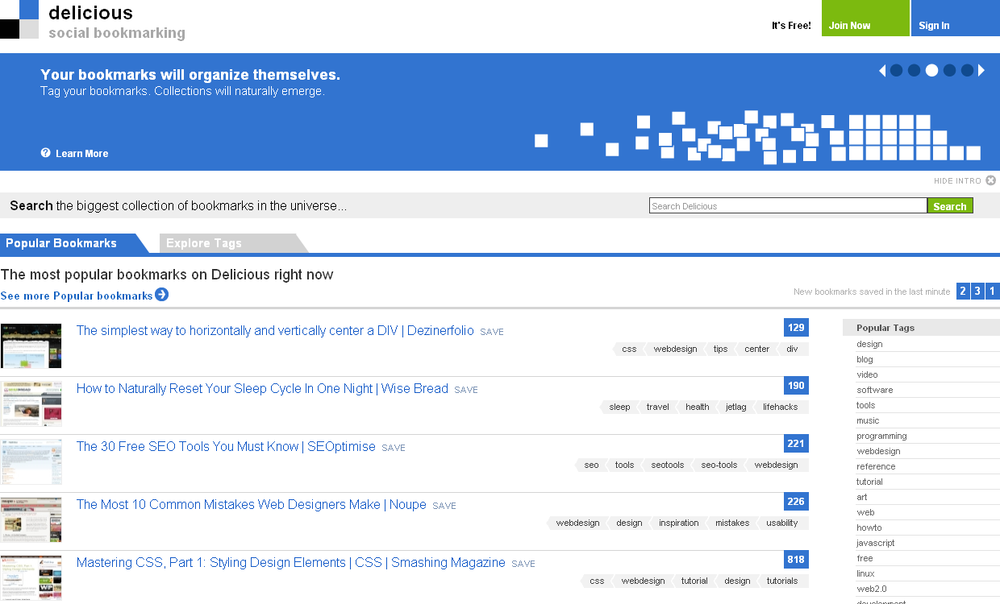Social news sites are websites that allow users to submit and vote on content from around the Web. This voting activity helps isolate the most interesting links. Marketers have found these sites to be very useful for generating buzz and traffic around specific campaigns or articles, but direct marketing on social news sites is typically frowned upon.
Social bookmarking sites are similar to social news sites, but the value presented to users is focused on allowing them to collect and store interesting links they've found and may wish to revisit. Most bookmarking sites count the number of times a piece of content has been stored and interpret these as votes to highlight the most valuable links (see Figure 6-1).
The first social bookmarking site, ITList, launched in April 1996, and from that point until the pop of the first dot-com bubble, a plethora of sites offering public and private online storage of your favorite links emerged. However, most of them died in the late 1990s.
In 1997, Slashdot was launched as a place where users could submit links to technology stories. It became enormously popular, and was the first social media site to wield server-crushing amounts of traffic, known as the Slashdot Effect, when a link was posted to its home page. Two years later, a site called Fark was launched to serve a less technical and more irreverent niche. Shortly after its launch, Fark expanded to allow readers other than the site's owner to upload links.
Social news and bookmarking reached its widest audience with the advent of Delicious in 2003 and Digg in 2004. Digg relies on the wisdom of its audience to filter the most interesting articles from the thousands that are submitted every day.
Social news sites focus on delivering the latest news based on votes. Bookmarking sites allow users to save links for later reading; the number of saves counts as votes and the most popular links are displayed. These sites all have certain elements that are useful to marketers. This section will introduce you to those elements.
Social news and bookmarking sites each have slight variations regarding user profiles. For those that allow you to upload an avatar image (and most do), you should use the same image across all sites; this should also be consistent across social networks and any other sites where you have a profile. Fill out as much profile information as you can, including instant messenger (IM) names, profiles on other sites, and links to your websites. Some sites also allow you to friend other users, as on social networks; find people submitting and voting on content similar to yours and connect with them.
The more active and consistent you are in contributing to a site, the more valuable your account will become; you'll begin to develop a reputation, and other people will be more receptive to your stories. If you are a regular reader of blogs and news sources in your niche, you'll have the advantage of being the first person to submit major stories.
To get your content listed on a social news site, you have to submit it. During the submission process, you'll be asked to provide a headline, a short description of the content of the page, the category it should be listed in, and some tags to describe it.
Most communities frown on people who submit their own content, so avoid doing this. Instead, cultivate a community of active social news users on your site, and display links for them to submit your content. Making friends with power users is also a great idea, and it's something I'll talk about a little later in this chapter.
The central action of interest to marketers on social news sites is voting. Different sites call it different things, and some don't even specifically label it, but the idea is the same: a piece of content is submitted to a site, and other users vote on it, either up or down. The number, quality, and speed of votes determine how popular your content is. Pieces of content that receive sufficient votes are promoted to a section of popular content, a process called going pop that I'll detail later in this chapter.
Many social news sites offer badges that you can copy and paste onto your site (see Figure 6-2). Once your content has been submitted to one of these bookmarking sites, add a badge to your page so that your readers can vote it up or down without leaving your site. These buttons are great for promoting your content. You should place them as prominently on your content as you can when you think that a specific page has a good chance of doing well on a certain social site.
On a social voting site, the most important element of a story is the headline. This has the greatest effect on how many votes a story gets, and is the only thing many users will read. The title of a blog post or a page is typically what a user submits, so spend some time writing a great headline (see Figure 6-3).
Good headlines give the impression that the content that follows them is easy to digest, entertaining, and valuable. Try to explain exactly what the user will get out of reading your content. If your content is a photo or a video, specify that in the title; if it is a list (such as a top 10 best list), put that in the headline.
Your titles should be eye-catching and provocative, but not misleading. Users on social sites are very savvy and will figure out your tricks much faster than you think.
Coined by Rand Fishkin of SEOmoz, the term linkerati refers to a class of individuals on the Web who are more likely than other users to have their own blogs or websites where they can link to content they find interesting. When marketing to social news sites, the linkerati are your target, as many of them frequent these sites and will blog about content they find there. Research I did on Digg in 2007 showed that the average popular page got about 300 links.
The ultimate goal of marketing on social news sites is to get your content listed as "popular." Voting sites have sections, typically on their home page, where they display the content that has been voted as most popular. Once a page has enough votes and is exposed to a larger audience, it will often start an avalanche of increasing vote counts; stories that have gone popular often have many more votes than those that have not (see Figure 6-4). Appearing here can drive tens of thousands of visits to your site and get it in front of the linkerati; the combination of these two actions often results in hundreds or thousands of incoming links.
When your content is listed on the front page of a site such as Digg (especially during peak daytime hours), your server will be hit with a crush of visitors, sometimes thousands per minute. Most shared-hosting environments have trouble dealing with traffic volumes this large, and having an unresponsive page squanders most of the benefit of going popular. You can solve this problem by either upgrading your server or implementing a caching system. The goal of a caching system is to ensure that your pages are not requesting information from a database on every page load, which is often what causes a site to crash during periods of high activity. Talk to your technical person to figure out the best solution before you start submitting pages to social news sites.
The number of people who vote on your content—and see it once it goes popular—is largely a function of timing. Hitting the front page of a social news site in the middle of the night will not result in the kind of traffic spike that comes from going popular during business hours. Many sites have a window of time from submission during which a site can go popular; stories on Digg, for instance, have 24 hours to make the front page. Getting a story submitted on Digg 18 to 22 hours before a peak usage hour is ideal, meaning you should be looking for submissions between 4:00 a.m. and midnight (see Figure 6-5).
Certain users gain recognition and authority on the basis of the quality, consistency, and longevity of their submissions. This type of power user often has hundreds of friends who will vote for almost every story he submits; this means the content he posts is more likely to become popular than content posted by an unknown user.
One strategy for promoting your content is befriending these power users. Digg allows users to display their IM usernames, so you can find users who appear on the front page often and seem to enjoy content related to yours, and then say hi to them via IM. Be cautious when approaching these users, and don't start pitching your content at them right away; get to know them and the content they like, follow them on Twitter, and build relationships before you start asking for favors.
The concept of "you scratch my back, I'll vote on your stories" is a controversial but powerful one. When you make friends on social news sites, the common understanding is that this friendship is built on sharing and voting on one another's stories. Some users compile lists of their voting buddies' IM names or email addresses and share stories with them that way. This activity borders on violating most news sites' terms of service (ToS), so as a new user, you shouldn't do it.
A number of content formats typically work well on social voting sites:
- Lists
Top 10 types of lists give off the scent of easy-to-read content, and people love to rank things. Write a list of the 10 best, the 7 worst, the 9 geekiest, or the 5 most expensive things in your industry (see Figure 6-6).
- Breaking news
When big news breaks, it appears in the popular lists on most voting sites quickly. If you can be the first to write about something big happening, you'll have a good shot at going popular.
- Games
Casual games that can be played in a browser window do well on these types of sites. Simple, addictive games can be developed with minimal investment by most coders.
- Controversy
Social media users love to argue; if you can present a well-constructed argument against a commonly held belief, you can get lots of votes. This works well when used against corporations, groups, or people perceived as "bad." The RIAA and Microsoft are favorite targets.
- Videos and photos
Short videos and surprising photographs (especially in collections) are easy and quick for viewers to consume, and are well received by social news and voting sites.
Digg (see Figure 6-7) is the most popular social news site and the standard by which all others are measured. It is the most well-known site of its kind, and although it has made great strides to include nongeeky news, its core users are now and always have been twentysomething male techies. When a story reaches the Digg front page, it appears at the top of a chronological list and is pushed farther down the page as newer stories are promoted. Because Digg is so active, a story will appear on the front page for only a few hours.
Digg's negative voting comes in the form of buries. The number of negative votes is not shown, and the exact weight of a down vote compared to an up vote is unknown. The site is home to a boogeyman of sorts in the mythical "bury brigade," a supposedly organized group of users who bury any stories they don't like. Common targets are those that support organizations or topics disliked by the community, such as Microsoft or marketing.
If your content is not standard geek fare, you can still get on the front page of Digg by spinning your content with a technical angle. If your business is house painting, you can write an article about the 10 best ways to paint the Digg logo on the side of a building; if you sell furniture, try collecting pictures of geeky office fixtures. Be cautious with this tactic, as this audience is quite savvy and has learned to recognize obvious front-page attempts. But try out a few new types of content to expand your reach and see what works for you.
Once you submit a link to Digg (see Figure 6-8), it has 24 hours to reach the front page. The algorithm controlling promotion is shrouded in mystery, but it is probably composed of factors including the number and speed of votes, the variety of users voting, the number of comments left on a story, and a measurement of trust associated with a domain. Most of the articles that do well on Digg are from popular news sites and blogs; one way around this is to place your content on a trusted domain and promote that URL. For instance, you could create a video, upload it to YouTube, and get the YouTube link submitted as opposed to your own, relatively unknown domain.
Digg has a strong tradition of power users and a robust networking component, which makes the submitter of an article very important. Some articles will go popular after 80 votes, and some won't despite getting well more than 200 votes. Stories that don't reach Digg's front page receive very little traffic, but those that do can expect tens of thousands of hits in a few hours.
Going popular on Digg can result in hundreds of links, so it has become a target for many marketers. Because of this, it has sophisticated algorithms in place to thwart gaming, and it has become increasingly difficult to get pieces of content from domains that aren't very well known onto its front page.
Perennially in second place in the social voting race, Reddit still drives substantial amounts of traffic (see Figure 6-9). And, as opposed to the all-or-nothing nature of Digg, Reddit sends some traffic to stories that don't quite go pop. Reddit's front page works more like a leader board than Digg's chronological list system. Stories can move up or down on it as they are voted on, meaning that a story can stay in a prominent position on Reddit for longer than it can on Digg.
Reddit has very little social networking functionality, so the power accounts aren't as important on Reddit as they are on other sites. Redditors are similar to Diggers (twentysomething geeks), albeit the former are slightly more educated and gender neutral.
Down-voting on Reddit is done by way of a down arrow that is placed directly under the corresponding up arrow. A story's score is the number of positive votes it has received minus the number of negative votes, and both numbers are displayed clearly, making Reddit the most transparent site in this regard. Content that gets a lot of up and down votes can appear on a separate "controversial" section of the site, meaning that a few down votes isn't the worst thing that can happen.
Reddit seems to place a lot of weight on the speed of voting; stories that get tens of votes in the first hour can get to the bottom of Reddit's front page. If some of your content gets submitted, you should act quickly and add a voting badge to it to encourage a speedy influx of votes. Figure 6-10 shows an example of a popular story on Reddit.
Reddit is composed of multiple sub-Reddits for different categories. Users can select which sections they see on the home page, so category selection is crucial. When a user visits the Reddit home page, she will see popular stories from a handful of default sections, including Comics, Funny, Pics, Politics, Programming, Science, Technology, World News, WTF, and a miscellaneous "Reddit.com" sub-Reddit. These sections get much more traffic than the others, so focus on them when submitting.
Perhaps the most mainstream social bookmarking site, StumbleUpon also differs from the standard voting site interface. Rather than a front page with a list of popular links, StumbleUpon lets users interact with it through a browser plug-in that allows them to "stumble" from page to page across the Web with the click of a button. When you see a page you like anywhere on the Internet, you click on a thumbs-up icon—as opposed to the thumbs-down icon for bad content. The system learns what kinds of content you like from these votes and starts to show you targeted pages as you stumble.
Most social news sites send a huge spike of traffic in the hours after a story goes popular, that tapers off quickly. StumbleUpon, however, has been known to send wave after wave of traffic to pages that were first discovered (submitted in StumbleUpon lingo) months ago. It also exhibits less all-or-nothing behavior, as a few votes can result in a couple of thousand hits.
Because of its older, less technical audience, StumbleUpon favors less geeky content, impressive photographs, short videos, and games (see Figure 6-11). The personalization system also allows a wider range of topics to be delivered to interested audiences. If you're having trouble giving your story a nerdy enough angle to do well on Digg, StumbleUpon might be the right place for you.
Delicious focuses on storing your bookmarked links, and its social functionality takes a bit of a back seat. Bookmarking a page counts as a vote, and there is no down-voting mechanism. Stories that are saved enough times in a day or two (the exact threshold varies, but it is a bit more than 100) are shown on the Delicious front page and get a few thousand hits (see Figure 6-12).
From the user's perspective, bookmarking is a different action than voting, so the short-form content that does well on other social news sites doesn't work as well on Delicious. Users are more likely to save pages they'll want to come back to later, such as long articles and useful resources. If you want to get on the front page here, try compiling a list of tools that nobody could possibly read in a single sitting, or develop a tool that your readers will want to use regularly.
Each of the most well-known popular social news sites has its own audience likes and dislikes; and as a site gains notoriety, it becomes increasingly difficult for content to go popular. If your site does not fit neatly into the profile of one of the big sites, you can try to create content that serves those niches while being only obliquely related to your business, or you can target one of the smaller, niche social news and voting sites. The following list is in no way exhaustive, but is meant to demonstrate the wide range of social news and bookmarking sites on the Web.
- Kirtsy (http://kirtsy.com/)
Referred to by some as "Digg for girls," Kirtsy has categories for crafts, parenting, fashion, and food. If your target audience is women, Kirtsy is a good place to start.
- Tip'd (http://tipd.com/)
Tip'd focuses on finance, investing, and business (see Figure 6-13). Check it out if want to get your content in front of investors.
- Sphinn (http://sphinn.com/)
The search and social media marketer's voting site, Sphinn (shown earlier in Figure 6-1) includes stories about SEO, PPC, domaining, and affiliate marketing.
- Hacker News (http://news.ycombinator.com/)
Grown out of the funding firm Y Combinator, Hacker News carries technical content and "anything that a hacker might find interesting."
- Care2 (http://www.care2.com/)
Care2's goal is to make the world a better place through green living. The site has news about a variety of causes, including animal welfare and environmental policy.
Social news and bookmarking sites are a great way to drive thousands of visitors and hundreds of links to a specific page.
Set up your profile as completely as each site will allow.
Write a compelling headline that tells visitors exactly what the article will offer them.
Be sure ahead of time that your server can handle a huge spike in traffic.
Use voting badges to make it easy to vote on your content.
Consider the culture of each site and target your content appropriately.

